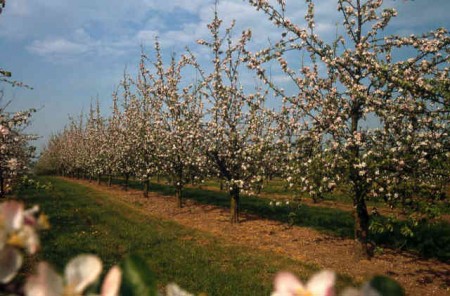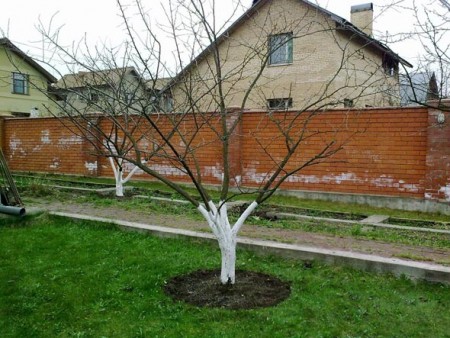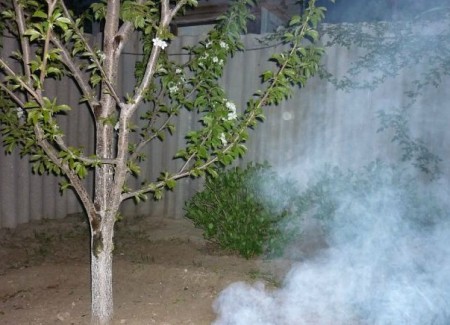Gardeners are often concerned about the lack of fruiting of young trees or the low yield of mature trees. Most often, the reasons are insufficient agrotechnical garden care...
1 REASON: lack of annual pruning.
At a young age, it is necessary to form a crown that is strong, compact and well-lit. Systematically prune young strong trees, otherwise they will thicken and tops will begin to form.
To prevent branches from being exposed, shorten them. But you shouldn’t get carried away with shortening, because this delays the trees’ beginning to bear fruit, and the crown becomes very thick with frequent shortening. At a young age, moderate shortening and moderate thinning are required. Adjust the growth force of the branches by changing the angle of inclination (spacers, garter, etc.). Change the direction of branch growth by pruning.
Cut out shoots into a ring - competitors growing on the trunk, thickening, broken, diseased, as well as branches growing inside the crown and interfering with soil cultivation.
Pruning fruit-bearing trees.
One of the reasons for poor fruiting and even lack of fruiting in mature trees is improper pruning.
By 4-5 years the trees begin to bear fruit. In order not to reduce the yield, do not trim branches of moderate length (up to 20-30 cm): their lateral buds are generative. Trim only long growths (at least 40-50 cm) to enhance their branching.
Remove the upper part of the central conductor (along with the branches), leaving a length of no more than 1.2-1.5 m.
It is pruned by transferring it to a side branch on the eastern side.
Remove the branches without leaving a stump to prevent the formation of fatty shoots. If they appear, they are broken out green.
Trees with small growth (5-15 cm) require stronger, more detailed pruning. When the length of annual growths decreases, the fruiting wood (rings) dies off. And good fruiting can be ensured only on 2-3-year-old ringlets located on young, strong growths.
Bare branches, insufficient branching, and lack of growth activity are signs that the tree needs rejuvenating pruning.
Pruning old trees.
To renew aging fruits when growth is reduced to 20-25 cm, small rejuvenating pruning is carried out. Shorten some of the branches for 2-3 year old wood.
When the growth of skeletal branches weakens, it is necessary to prune to perennial wood.
If there is a complete absence of growth, the trees are rejuvenated to 6-8 year old wood. It is better to carry out rejuvenation during a low-yield or lean year (tree growth is restored faster).
Rejuvenation is necessary for both young trees with weakened growth and those bearing fruit.
Shortening is done in the area of dormant buds, where the growth was at least 30-40 cm. In this place, a cut is made above the annual ring with a stump of 5-7 cm. In this way, the crown of previously unformed trees can be corrected. Sharp corners can be corrected by bending the branch or cutting it to a lower one.
2 REASON: lack of pollinator.
This does not apply to self-fertile varieties (plants that set fruit well when pollinated by their own pollen).
If a variety is self-sterile, it definitely needs a pollinator.
Self-fertile cherry varieties include
- Lyubskaya
- Youth
- Shubinka
- Lighthouse
- Generous
- Finaevskaya
Almost all varieties of apple, pear, quince, cherry, and most varieties of berry and subtropical crops are self-sterile. In single-varietal plantings, they do not set fruit or produce few fruits. Self-sterile cherry varieties include:
- Vladimirskaya
- Consumer goods black (Morel black)
- Griot Moscow
- Turgenevskaya
The pollinator should grow no further than 50 meters. For example, for the self-fertile pear variety Vere Klerzho, the Vere Vosk variety will be required for cross-pollination.
Gardeners have become convinced that if several trees of the same variety grow on a site (for example, the self-fertile variety of Vladimirskaya cherry), but there are no trees of other varieties (Lyubskaya, Rastunya), then the Vladimirskaya cherry can bloom profusely, but bear very little fruit.
Therefore, other varieties of cherries are planted next to it, blooming at the same time. Or the Kentskaya variety (Black Morel) is practically self-sterile; it definitely needs Rastunya or Podbelskaya for pollination. The self-fertile variety Zhukovskaya sets fruit well only when cross-pollinated by the self-fertile variety Lyubskaya.
Self-fertile varieties are always more productive and bear fruit in any weather (rain, wind, etc.). If the variety is self-fertile or partially self-fertile, a pollinator variety will also help it for abundant fruiting: the yield will be higher.
For example, for the self-fertile cherry variety Amorel pink, the best pollinators are Lyubskaya and Vladimirskaya. The main thing is that on the dacha there should be several varieties of cherry trees that bloom at the same time or almost simultaneously.
3 REASON: frosts during flowering.
Select late-flowering varieties with increased winter hardiness of fruit buds. Buds die at a temperature of minus 4 degrees (apple tree, pear, plum), at minus 2 (cherry), flowers at minus 2, ovaries at minus 1.2 degrees (apple tree at minus 1.8). The following cherry varieties tolerate spring frosts more easily:
- Lyubskaya
- Unwinding
- Apukhtinskaya
- Bagryannaya
Apple trees:
- Melba
- Malychenkovskoe
- Memory of Michurin
- Welsey.
A good remedy for frost when it occurs is sprinkling, which increases the air humidity around the trees. During freezing, frost is formed from droplets of moisture, the process occurs with the release of heat, and the temperature around the plants rises by 1-2 degrees.
Moistened soil allows heat to pass through well from the lower layers, so it cools slowly, which is also important, since frost occurs along the soil.
If the area is large, then a good remedy is smoking compost heaps or sulfur bombs. Smoke starts when the air temperature drops to zero, usually at 2-3 am.
Smoke heaps are laid out at a distance of 10-15 m from each other. Everything will go into heaps: brushwood, branches, especially wet ones, garbage. The upper part should contain poorly combustible material: sawdust, wet pine needles or wet rags. Burning should continue for at least 3-4 hours.
4 REASON: bad weather
In rainy weather, pollinating insects do not fly, and the harvest may be lost. In such weather, it is useful to spray the garden with ovary formation stimulants. These are solutions of Bud, Ovary, Gibbersib (stimulate the formation of fruits without pollination).
During flowering, you can sprinkle the crowns of apple trees with honey (1 teaspoon per 3-4 liters of water).
Drought is harmful to pollination. At temperatures above +30 degrees, flowers do not produce nectar that attracts pollinating insects. In addition, at +30 and above the number of bees stops.
5 REASON: pests and diseases
Almost the entire harvest of both pome and stone fruits can be destroyed by insect pests. Before flowering, damage is caused by weevils. At this time, trees are treated against them with spark, actara, fufanon-nova.
You can use them in a mixture with chorus (2.5-4 g) against moniliosis and coccomycosis. Trees are sprayed with Horus before flowering, in the first two days of flowering or after flowering. Alatar or actara is added to the chorus solution. In cold weather, before flowering, strobes are used on apple trees against scab and moniliosis.Hom (40 g) or chorus will protect stone fruits from hole spot and coccomycosis.
6 REASON: improper placement of trees in the garden.
Fruit trees grow well in sunny places, protected from cold air. The distance between trees is at least 3-4 meters. Cherry, for example, fails in depressions and on lower slopes. Plum trees produce almost no harvest if they are located in ravines on northern slopes. The plum tree grows and bears fruit best near the southern wall of buildings that protect it from the winds.
The tree crown is well illuminated if its width (diameter) does not exceed 2.5 m.
7 REASON: poor diet
Correct application of mineral and organic fertilizers determines the health of fruit trees: large green leaves, normal growth and abundant fruiting. With the help of fertilizers, you can increase the resistance of plants to diseases and pests.
Organic fertilizers are applied once every 2-3 years. On poor soils annually. In the fall, green manure is sown and their green mass is embedded in the soil for digging. For digging, superphosphate (30-50 g) and potassium fertilizers (10-30 g) are added per square meter.
Potassium sulfate can also be added in summer. It is easily mixed with other fertilizer and does not contain harmful impurities. Potassium fertilizers are highly soluble in water.
Nitrogen fertilizers are applied in early spring, complex fertilizers in mid-summer, and phosphorus fertilizers in the fall. Superphosphate is poorly soluble in water, and therefore it is applied before digging the soil in the fall, as well as in mid-summer if abundant fruiting is expected. It is more effective to mix it when applied with compost or manure.
Double superphosphate mixes well with nitrogen fertilizers and organic matter. Phosphorus fertilizers are applied to the depth of the root system.Phosphorus is practically not washed into the lower layers of the soil.





 CUCUMBERS NEVER GET SICK, I'VE BEEN USING ONLY THIS FOR 40 YEARS! I SHARE A SECRET WITH YOU, CUCUMBERS ARE LIKE THE PICTURE!
CUCUMBERS NEVER GET SICK, I'VE BEEN USING ONLY THIS FOR 40 YEARS! I SHARE A SECRET WITH YOU, CUCUMBERS ARE LIKE THE PICTURE! You can dig a bucket of potatoes from each bush. Do you think these are fairy tales? Watch the video
You can dig a bucket of potatoes from each bush. Do you think these are fairy tales? Watch the video
 How our fellow gardeners work in Korea. There is a lot to learn and just fun to watch.
How our fellow gardeners work in Korea. There is a lot to learn and just fun to watch. Eye trainer. The author claims that with daily viewing, vision is restored. They don't charge money for views.
Eye trainer. The author claims that with daily viewing, vision is restored. They don't charge money for views. A 3-ingredient cake recipe in 30 minutes is better than Napoleon. Simple and very tasty.
A 3-ingredient cake recipe in 30 minutes is better than Napoleon. Simple and very tasty. Therapeutic exercises for cervical osteochondrosis. A complete set of exercises.
Therapeutic exercises for cervical osteochondrosis. A complete set of exercises. Which indoor plants match your zodiac sign?
Which indoor plants match your zodiac sign? What about them? Excursion to German dachas.
What about them? Excursion to German dachas.